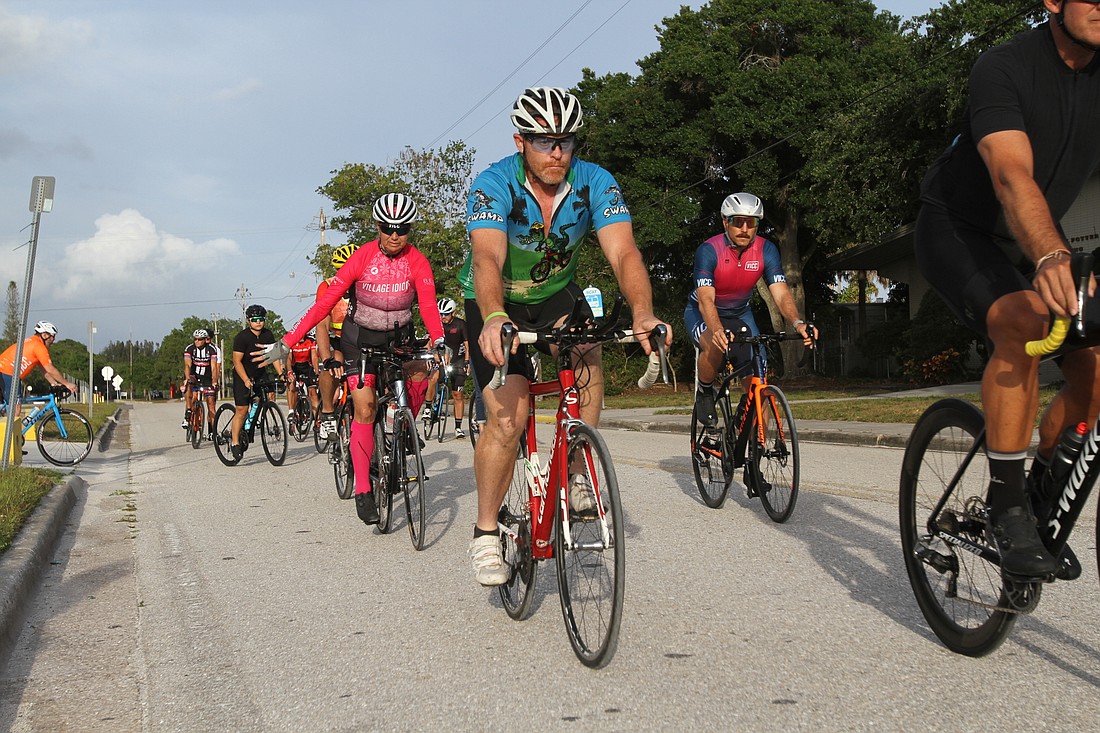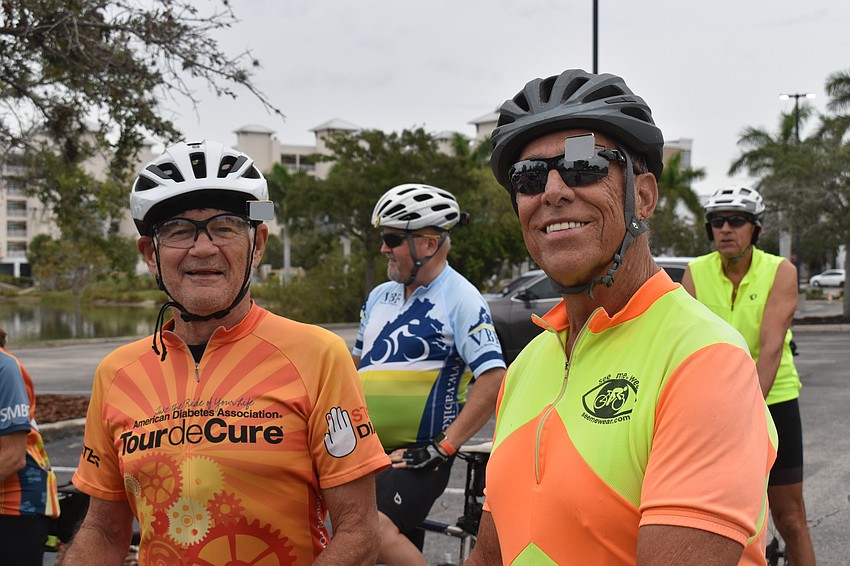- July 26, 2024
-
-
Loading

Loading

Manatee County law enforcement officers, bicycle club members and bicycle safety advocates were not surprised that a study has named Florida the deadliest state for cyclists.
But they all say with proper attention to safety measures, Florida could lose that designation.
The study comes from a personal injury lawyer out of Ohio, John Fitch, who analyzed the National Highway Traffic Safety Administration’s fatal crash data from 2017 through 2021. Fitch found that 805 out of 9,472 road fatalities in Florida involved cyclists.
Florida Highway Safety and Motor Vehicles maintains a crash dashboard on its website. The statistics date back to Jan 1, 2018 and since then, the dashboard shows 814 bicycle crashes in Manatee County that resulted in 752 injuries and 34 fatalities.
“Within the last four to five years, the state of Florida has been No. 1 or No. 2 in pedestrian and bicycle fatalities,” said Sgt. Robert Spurlock of the Manatee County Sheriff’s Office. “The last two years, (Florida has) been No. 1 in bicycle fatalities, but we bounce around from one and two on both of those.”
While Fitch concluded that cyclists are most at risk in states with a higher likelihood of ice and snow, sunny states like Florida, Hawaii and California are heavily impacted by the number of vehicles on the road. In 2018, the NHTSA reported that 79% of road accident fatalities occurred in urban areas.
Spurlock said most of the accidents in Manatee County happen on thoroughfares during the day and early evening, which coincides with traffic patterns, and that continued road improvements can lower crash numbers simply by design.
For example, 44th Avenue East, when finished, will parallel State Road 70 from east to west. The road will alleviate traffic, but its newer design incorporates bike lanes and safety features that weren’t included when S.R. 70 was built.
But having upgraded roads to travel won’t help if travelers don’t abide by the rules. Most of the crashes that the Sheriff’s Office sees are pedestrian- and bicyclist-caused accidents.
“They’re going against the flow of traffic and right-of-ways. It’s a bicyclist moving or doing something that the driver wouldn’t think they would do,” Spurlock said. “That’s why our numbers are so high. Use the crosswalks and intersections because that’s where drivers are taught to look for pedestrians and bicyclists.”
The Sheriff’s Office has found that riding with a bike club is the safest way to go and that the “in-betweeners” are the most likely to be injured. Novice cyclists will use sidewalks to stay out of traffic, and experienced cyclists are road savvy and often ride in packs.
“I believe that one out of every so many motorists just doesn’t see you, and if you’re by yourself, you can blend into the background and they’re looking straight ahead,” said Brad Herrington, a volunteer coordinator with the Sarasota Manatee Bicycle Club. “It happens sometimes even with a group. I remember being with a group of maybe seven people. This car went by really close, and someone said, ‘She did not even see us.’”
It’s not only the number of cars on the roads, Florida’s endless summer keeps bikes on the roads year-round.
“I’m from Canada,” SMBC member Kelly Borgers said. “I started riding with this club and went, ‘Oh my gosh, I can ride every day.’ November is crappy at home.”
Spurlock has been with the Manatee County’s Sheriff’s traffic unit for 12 years. One cycling fatality, in particular, that happened early on in his career has stuck with him. The cyclist was crossing the intersection of S.R. 70 and U.S. 301 on his way to the movie theater when the motorist violated his right-of-way.
“He didn’t do anything wrong. He was in the crosswalk. He was following the cross signs, and he ended up getting hit,” Spurlock said. “Had he had a helmet on, according to the medical examiner’s office, he probably would’ve had a headache, maybe got a concussion, but that would’ve been it.”
According to the Florida Department of Transportation, bicycle-related injuries send more children ages 5-14 to the emergency room than any other sport, and in many cases, they’re being treated for head injuries.
FDOT issues grants to community partners all over the state, so they can then distribute free bike lights and helmets.

Jay Walsh was leading the pack of SMBC cyclists leaving Lakewood Ranch Town Hall on the morning of Nov. 15. Before heading out, he gave a safety brief, which happens before every ride the club coordinates.
The briefs vary from person to person, but they’re mandatory along with helmets and using hand signals. The club also tries to stick with groups of no more than eight riders and stresses the importance of front and back lights along with brightly colored clothing.
“Communication is the biggest thing,” Walsh said. “Everyone knows the signals. Everyone points out the debris.”
Debris is a major hazard cyclists need to watch for when riding.
“The most recent crashes I’m aware of were caused by some construction material in the bike lane,” Richard Garrett, a bike safety advocate, said. “There’s two choices. They go over it and fall, or they ride into the lane where there’s traffic, and that’s an even worse situation.”
Garrett serves on the board of directors for the Florida Bicycle Association. He questions if the data shows the full picture when it’s only coming from police reports.
“The statistics that are being provided to the Florida Department of Transportation do not include all of the hospital trauma admissions or bike accidents that get taken directly to the hospital by passenger car or even some EMT services,” Garrett said. “In my opinion, it could be underreported by 50 to 90%.”
Charlotte Jackson, a data scientist in Washington, D.C., listened in on six weeks of local 911 calls this year. She found that, on average, 30% of car crashes involving a cyclist or a pedestrian go unreported. In 2018, the NHTSA reported that a survey of more than 7,000 bicyclists from 17 countries found that, on average, only 9% of bicycle crashes were reported to the police.
Garrett said county engineers need to work with bike clubs during the design phase more, so both goals of faster moving traffic and safe, comfortable cycling can be achieved.
“If you’re going to design it, then you ought to be able to ride it,” Garrett said. “I’ve asked several engineers to come out and ride their bikes with me through a roundabout or a common ride where the groups go, but everybody refuses.”
Garrett said roundabouts, in particular, are troublesome for cyclists. Drivers tend to look left entering a roundabout, but cyclists are merging into the roundabout on the right. Longer merge lanes and even simple signs alerting drivers to the bike lane could make roundabouts safer.
“Better coordination between the biking community and the engineers can help improve safety,” Garrett said.